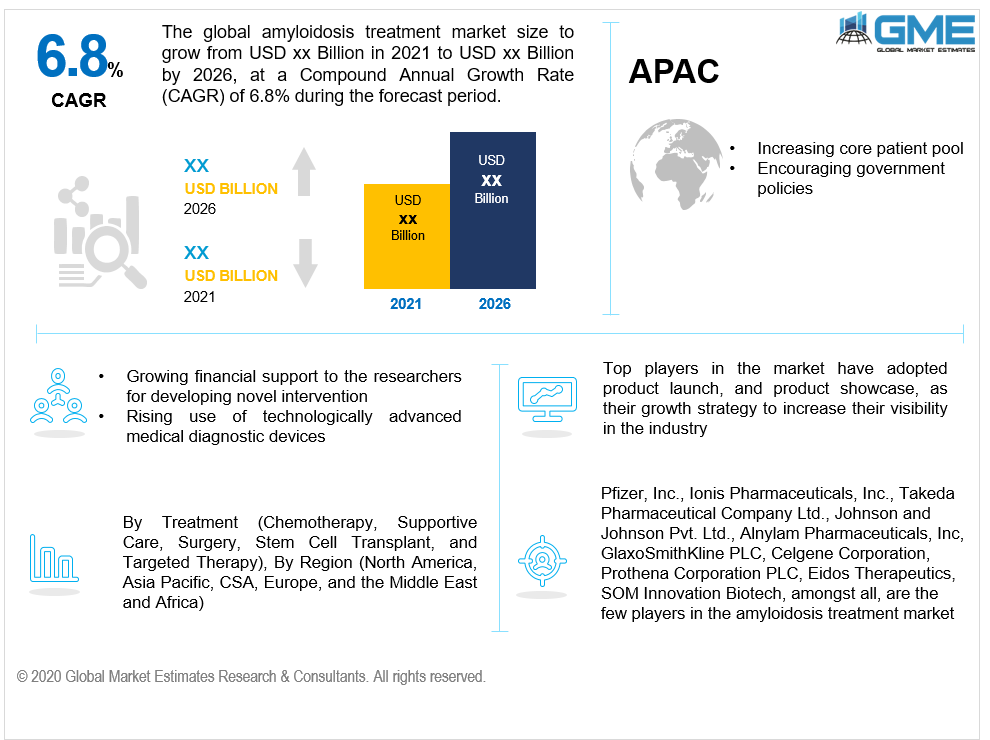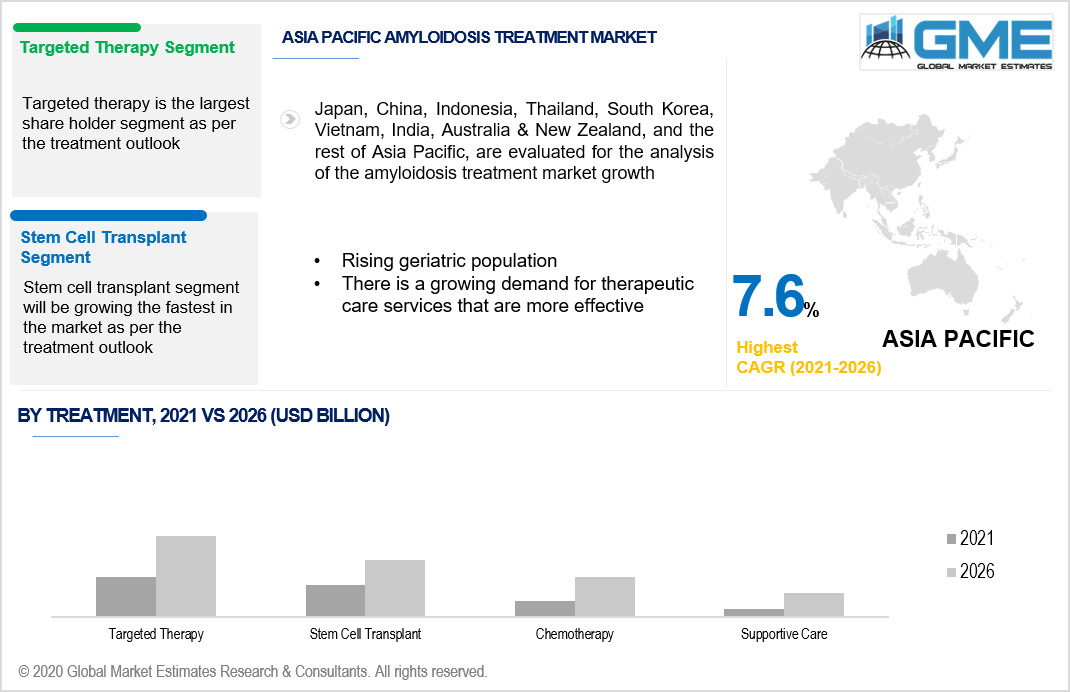
Global Amyloidosis Treatment Market Size, Trends & Analysis - Forecasts to 2026 By Treatment (Chemotherapy, Supportive Care, Surgery, Stem Cell Transplant, and Targeted Therapy), Competitive Landscape, Company Market Share Analysis, and Competitor Analysis
Amyloid is an antigen that is formed abnormally in the bone marrow. Amyloidosis is a rare condition triggered by extracellular and intracellular amyloid accumulation, which disrupts the tissue's natural functioning and most often impacts many vital organs of the human body. In its later stages, a severe type of amyloidosis may cause permanent organ loss and, in rare cases, death. There are more than 30 different forms of amyloid proteins known so far, and therapy will only help manage symptoms and regulate amyloid protein activity while some forms of amyloid do not have a permanent solution. As per the American Society of Haematology, amyloidosis affects around 1 in every 95,000 people in the United States, with males accounting for 62 to 65 percent of cases. Per year, systemic amyloidosis kills almost 1 in every 1,500 people globally.
The key market forces that are accelerating the amyloidosis treatment market are the aging population and the elevated prevalence of amyloidosis in these demographics. Beneficial healthcare investment opportunities in many countries have led to a rise in demand for amyloidosis treatment. Throughout the forecast period, a robust pipeline of transthyretin amyloidosis therapy in the United States is expected to fuel the demand growth in North America. The expansion of the global market is being further triggered by the increase in special designations for specialized medical professionals from regulatory authorities. The demand is growing globally due to the significant financial funding for researchers to design new therapeutics interventions for amyloidosis.
Growing market competition and strategic alliances can help to strengthen the market position of various treatment options available for amyloidosis. High demand for disease-specific innovative treatment procedures will also propel the amyloidosis market. For instance, the biopsy is the most commonly used screening technique for amyloidosis, as well as alkylator-based chemotherapy, which is successful in approximately two-thirds of patients. Non-invasive scans, including echocardiography of the heart and X-rays of bone anomalies, can offer useful insight but are insufficient to detect amyloidosis.
Favorable funding and payment services in developing economies are significant drivers of the global amyloidosis industry. On the other hand, in some nations, the limited expense on medical care and the lack of understanding could stifle the amyloidosis treatment market's growth. There is reportedly a growing volume of medication treatments authorized for the management of amyloidosis in the market. This is expected to boost demand for amyloidosis treatment medicines. Furthermore, a rising understanding of this uncommon lethal condition in developing countries is expected to drive development in the amyloidosis treatment market. Coupled with this advancement in therapeutic methods, changing medical infrastructure, and accelerated economic development of nations, the amyloidosis market is likely to expand throughout the forecast period.

Depending on the treatment, the market can be segmented as chemotherapy, supportive care, surgery, stem cell transplant, and targeted therapy. Targeted therapy is leading in this market. In developing countries, targeted treatments and stem cell transplants are gaining popularity. In the global market, targeted therapy is expected to expand the most, led by stem cell transplant and surgery. The benefits of targeted therapy encompass the possibility for less damage to healthy cells, minimal side effects, and increased efficacy. Thus, it is preferred by a large volume of the medical professional and patient pool.
Due to the high percentage of hematological remission and long-term disease management following surgery, high-dose chemotherapy accompanied by autologous, stem cell transplant is the recommended medication for low-risk patients in the United States. Chemotherapy and supportive treatment are projected to lose market share during the forecast period as a result of negative side effects and lower effectiveness.

As per the geographical analysis, the market can be classified into North America (the US, Canada, and Mexico), Asia Pacific (India, China, Japan, Malaysia, Singapore, and Rest of Asia Pacific), Europe (Germany, United Kingdom, Italy, France, Spain, Netherlands, and Rest of Europe), Middle East & Africa and Central & South America. North America is foreseen to dominate the transthyretin amyloidosis treatment market due to increased understanding of the uncommon condition, increasingly integrated medical system, and growing treatment access. Furthermore, the choice of the strongest players in North America to introduce sophisticated therapeutic alternatives for amyloidosis management is a core demand multiplier for the area. Potential new drug launches, increased development of experimental therapeutics, and the high cost of medication in the United States are only a few of the reasons driving its dominance.
European nations, including Germany, France, and the United Kingdom, are projected to follow the lead due to successful federal policies concerning healthcare systems and the availability of qualified medical professionals. Asia Pacific is likely to develop at a reasonable pace and is foreseen to register the highest CAGR. Asia Pacific countries, including Japan, China, and India, are likely to contribute the most to this growth. Furthermore, due to favorable government policies, increased research project spending, and strengthened healthcare infrastructure, these emerging markets for amyloidosis are projected to expand rapidly throughout the forecast period. As per the United Nations study released in 2015, the global populace of individuals aged 60 and up is expected to increase by 56% during 2015 and 2030, with the Asia Pacific accounting for 66% of the aging population. This leaves the area susceptible to amyloidosis, as the likelihood of its occurrence expands with aging. Additionally, the demand will expand significantly throughout the forecast period due to increased adoption of healthcare technologies, government programs to improve treatment adherence, and the provision of attractive insurance and payment plans.
Pfizer, Inc., Ionis Pharmaceuticals, Inc., Takeda Pharmaceutical Company Ltd., Johnson & Johnson Pvt. Ltd., Alnylam Pharmaceuticals, Inc, GlaxoSmithKline PLC, Celgene Corporation, Prothena Corporation PLC, Eidos Therapeutics, and SOM Innovation Biotech, among others, are the few players in the amyloidosis treatment market.
Please note: This is not an exhaustive list of companies profiled in the report.
Chapter 1 Methodology
1.1 Market Scope & Definitions
1.2 Estimates & Forecast Calculation
1.3 Historical Data Overview And Validation
1.4 Data Sources
1.4.1 Secondary
1.4.2 Primary
Chapter 2 Report Outlook
2.1 Amyloidosis Treatment Industry Overview, 2019-2026
2.1.1 Industry Overview
2.1.2 Treatment Overview
2.1.3 Regional Overview
Chapter 3 Amyloidosis Treatment Market Trends
3.1 Market Segmentation
3.2 Industry Background, 2019-2026
3.3 Market Key Trends
3.3.1 Positive Trends
3.3.1.1 Technology Advancement in Healthcare Industry
3.3.1.2 Increasing Funds by Government to Develop Novel Medicines
3.3.2 Industry Challenges
3.3.2.1 Limited Study and Industry Participants
3.4 Prospective Growth Scenario
3.4.1 Treatment Growth Scenario
3.5 COVID-19 Influence over Industry Growth
3.6 Porter’s Analysis
3.7 PESTEL Analysis
3.8 Value Chain & Supply Chain Analysis
3.9 Regulatory Framework
3.9.1 North America
3.9.2 Europe
3.9.3 APAC
3.9.4 LATAM
3.9.5 MEA
3.10 Technology Overview
3.11 Market Share Analysis, 2020
3.11.1 Company Positioning Overview, 2020
Chapter 4 Amyloidosis Treatment Market, By Treatment
4.1 Treatment Outlook
4.2 Chemotherapy
4.2.1 Market Size, By Region, 2019-2026 (USD Million)
4.3 Supportive Care
4.3.1 Market Size, By Region, 2019-2026 (USD Million)
4.4 Targeted Therapy
4.4.1 Market Size, By Region, 2019-2026 (USD Million)
4.5 Stem Cell Transplant
4.5.1 Market Size, By Region, 2019-2026 (USD Million)
Chapter 5 Amyloidosis Treatment Market, By Region
5.1 Regional outlook
5.2 North America
5.2.1 Market Size, By Country 2019-2026 (USD Million)
5.2.2 Market Size, By Treatment, 2019-2026 (USD Million)
5.2.4 U.S.
5.2.4.1 Market Size, By Treatment, 2019-2026 (USD Million)
5.2.5 Canada
5.2.5.1 Market Size, By Treatment, 2019-2026 (USD Million)
5.3 Europe
5.3.1 Market Size, By Country 2019-2026 (USD Million)
5.3.2 Market Size, By Treatment, 2019-2026 (USD Million)
5.3.4 Germany
5.2.4.1 Market Size, By Treatment, 2019-2026 (USD Million)
5.3.5 UK
5.3.5.1 Market Size, By Treatment, 2019-2026 (USD Million)
5.3.6 France
5.3.6.1 Market Size, By Treatment, 2019-2026 (USD Million)
5.3.7 Italy
5.3.7.1 Market Size, By Treatment, 2019-2026 (USD Million)
5.3.8 Spain
5.3.8.1 Market Size, By Treatment, 2019-2026 (USD Million)
5.3.9 Russia
5.3.9.1 Market Size, By Treatment, 2019-2026 (USD Million)
5.4 Asia Pacific
5.4.1 Market Size, By Country 2019-2026 (USD Million)
5.4.2 Market Size, By Treatment, 2019-2026 (USD Million)
5.4.4 China
5.4.4.1 Market Size, By Treatment, 2019-2026 (USD Million)
5.4.5 India
5.4.5.1 Market Size, By Treatment, 2019-2026 (USD Million)
5.4.6 Japan
5.4.6.1 Market Size, By Treatment, 2019-2026 (USD Million)
5.4.7 Australia
5.4.7.1 Market Size, By Treatment, 2019-2026 (USD Million)
5.4.8 South Korea
5.4.8.1 Market Size, By Treatment, 2019-2026 (USD Million)
5.5 Latin America
5.5.1 Market Size, By Country 2019-2026 (USD Million)
5.5.2 Market Size, By Treatment, 2019-2026 (USD Million)
5.5.4 Brazil
5.5.4.1 Market Size, By Treatment, 2019-2026 (USD Million)
5.5.5 Mexico
5.5.5.1 Market Size, By Treatment, 2019-2026 (USD Million)
5.5.5 Argentina
5.5.6.1 Market Size, By Treatment, 2019-2026 (USD Million)
5.5 MEA
5.5.1 Market Size, By Country 2019-2026 (USD Million)
5.5.2 Market Size, By Treatment, 2019-2026 (USD Million)
5.5.4 Saudi Arabia
5.5.4.1 Market Size, By Treatment, 2019-2026 (USD Million)
5.5.5 UAE
5.5.5.1 Market Size, By Treatment, 2019-2026 (USD Million)
5.5.5 South Africa
5.5.5.1 Market Size, By Treatment, 2019-2026 (USD Million)
Chapter 6 Company Landscape
6.1 Competitive Analysis, 2020
6.2 Pfizer
6.2.1 Company Overview
6.2.2 Financial Analysis
6.2.3 Strategic Positioning
6.2.4 Info Graphic Analysis
6.3 Ionis Pharmaceuticals
6.3.1 Company Overview
6.3.2 Financial Analysis
6.3.3 Strategic Positioning
6.3.4 Info Graphic Analysis
6.4 Alnylam Pharmaceuticals, Inc
6.4.1 Company Overview
6.4.2 Financial Analysis
6.4.3 Strategic Positioning
6.4.4 Info Graphic Analysis
6.5 Johnson & Johnson
6.5.1 Company Overview
6.5.2 Financial Analysis
6.5.3 Strategic Positioning
6.5.4 Info Graphic Analysis
6.6 Takeda Pharmaceutical Company Ltd.
6.6.1 Company Overview
6.6.2 Financial Analysis
6.6.3 Strategic Positioning
6.6.4 Info Graphic Analysis
6.7 GlaxoSmithKline PLC
6.7.1 Company Overview
6.7.2 Financial Analysis
6.7.3 Strategic Positioning
6.7.4 Info Graphic Analysis
6.8 Celgene Corporation
6.8.1 Company Overview
6.8.2 Financial Analysis
6.8.3 Strategic Positioning
6.8.4 Info Graphic Analysis
6.9 Prothena Corporation PLC
6.9.1 Company Overview
6.9.2 Financial Analysis
6.9.3 Strategic Positioning
6.9.4 Info Graphic Analysis
6.10 Eidos Therapeutics
6.10.1 Company Overview
6.10.2 Financial Analysis
6.10.3 Strategic Positioning
6.10.4 Info Graphic Analysis
6.11 SOM Innovation Biotech
6.11.1 Company Overview
6.11.2 Financial Analysis
6.11.3 Strategic Positioning
6.11.4 Info Graphic Analysis
6.12 Other Companies
6.12.1 Company Overview
6.12.2 Financial Analysis
6.12.3 Strategic Positioning
6.12.4 Info Graphic Analysis
The Global Amyloidosis Treatment Market has been studied from the year 2019 till 2026. However, the CAGR provided in the report is from the year 2021 to 2026. The research methodology involved three stages: Desk research, Primary research, and Analysis & Output from the entire research process.

The desk research involved a robust background study which meant referring to paid and unpaid databases to understand the market dynamics; mapping contracts from press releases; identifying the key players in the market, studying their product portfolio, competition level, annual reports/SEC filings & investor presentations; and learning the demand and supply-side analysis for the Amyloidosis Treatment Market.

The primary research activity included telephonic conversations with more than 50 tier 1 industry consultants, distributors, and end-use product manufacturers.

Finally, based on the above thorough research process, an in-depth analysis was carried out considering the following aspects: market attractiveness, current & future market trends, market share analysis, SWOT analysis of the company and customer analytics.

Tailor made solutions just for you
80% of our clients seek made-to-order reports. How do you want us to tailor yours?
OUR CLIENTS